Mushy vision won't yield great transit
====
Oops. Forgot the Purple Line points, which are just added to the last item.
====
David Alpert, founder-editor of Greater Greater Washington, the area's leading "smart growth" blog (which has long since supplanted this one) has a piece, also will be printed in the Washington Post I expect, responding to Aaron Weiner's--the Housing Complex columnist for the Washington City Paper--valedictory on "what Washington should do" written as Aaron leaves WCP to bring neoliberalism to Mother Jones Magazine, says "where are the big transit ideas?" which he says are:
- Build new Metro lines
- At the very least, add some infill stations
- Stop building streetcar lines in mixed traffic
WRT the last point, these days, even building streetcar lines, let alone in mixed traffic, seems to be a "big idea."
-- "A Man, a Plan, a Canard: Panacea," Washington City Paper
-- Beyond Metro, there's no big idea for transit in DC anymore," GGW (lots of comments)
-- same piece in the Washington Post but with almost no comments
First I'd say, read my blog. Although most of my big ideas are pretty old by now. (My criticism of GGW, as the area's leading "urbanism blog" is that it doesn't push theory and practice and vision very far forward.) But I just did an update a few weeks ago, based on a query from Will Handsfield, Transportation Director for the Georgetown Business Improvement District.
-- "Transportation Wish List, 2015: part two, new ideas
-- "Transportation Wish List: 2015 edition, part one," (the original list, from entries in 2007 and 2008)
-- "What it will take to get WMATA out of crisis"
-- "Making the case for intra-city (vs. inter-city) transit planning"
-- "A National Mall-focused heritage (replica) streetcar service to serve visitors is a way bigger idea than a parking garage under the Mall"
-- "Night moves: the need for more night time (and weekend) transit service, especially when the subway is closed"
-- "Transit, stations, and placemaking: stations as entrypoints into neighborhoods"
-- "Making bus service sexy and more equitable"
-- "NCPC study on height limit: hearing, comments"
Second, having a brief period working for an executive branch in local government, in Baltimore County, in FY2010 (my ability to stay there was scotched by the fact that the incoming County Executive, after the November 2010 election, didn't retain the planning director, who was trying to find a way to bring me back) was my searing experience learning about how things really work in government, something that most advocates don't appreciate.
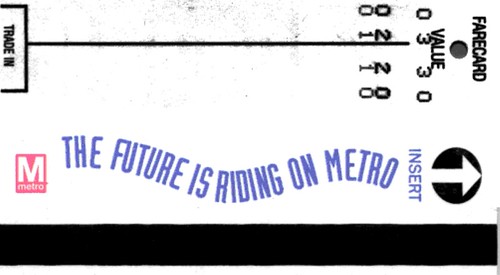
In short, only the elected officials really have power, and staff are circumscribed by what is allowed by the executive (or their legislative bosses, if they work for the legislative branch)--you do what you're told.
So to do anything "bold," there are some fundamental and foundational requirements, which are mostly missing in action from the metropolitan area and its jurisdictions:
(1) having a robust regional planning agency, the Metropolitan Planning Organization--in the DC area it is the Transportation Policy Board of the Metropolitan Washington Council of Governments -- but DC's is not considered a best practice leader nationally, and has limited vision. By default WMATA is the area's transportation planning agency, and they only care about subway and regional bus services.
(2) great elected officials who understand the value of transit and its centrality to quality of life and commerce both, with an ability to think very long term, about the future, rather than just for today, make hard decisions and "lead" rather than merely follow.
Under the Gray Administration, the heralded "economic development plan" didn't even mention transit as one of the city's key competitive advantages. The DC Chamber of Commerce's leading agenda item concerning mobility is better timing for traffic signals. AAA rails against the city for speed and traffic camera-based ticketing, and bike lanes, which to their way of thinking, takes away vital road space from the automobile.
(3) the ability to pay for transportation infrastructure expansion without relying on the federal government--in a time when the federal government is disconnected and uncommitted to making extra-normal investments in infrastructure for the Washington region of any kind, let alone transit, coming up with money is tough. The areas are poor--not DC because we are a city-state, but we are wasting money big time on unnecessary capital projects, which makes such forward investment very difficult.
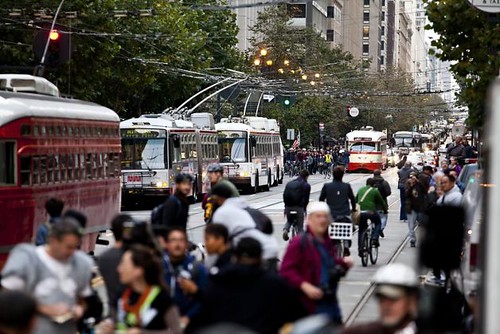
Critical Mass 20th Anniversary Ride, San Francisco, streetcars on Market Street. SF Chronicle photo.
Virginia added some financing capacity to Northern Virginia, but it still isn't enough. Maryland has encumbered a lot of their state transportation monies on roads.
I've suggested a transportation withholding tax--they have this in certain counties in Oregon, and in the transit catchment area for the Metropolitan Transportation Authority in New York State. France's version is called the versement transport. In the Paris region, this tax covers 40% of the operational costs of the area's transit systems.
(4) to pay for significant transit expansion, DC would have to authorize an increase in allowable height in Downtown buildings, which would significantly increase the city's commercial property tax base, which would then increase the city's capacity to issue debt without over-taxing the budget
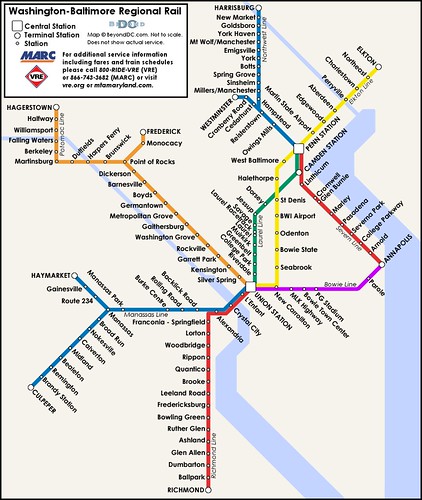
Dan Malouff's proposed map of a Washington-Baltimore regional passenger railroad system dates to the late 1990s.
(5) great planners and leaders of transportation and planning agencies across the region, to push for and make the case for integrating transportation and land use planning, and to take the heat from residents for doing it -- look at the strife over light rail in Suburban Maryland and over streetcars in DC and Arlington County.
E.g., DC has failed to lay out next generation urban design for the Rhode Island and Fort Totten transit catchment areas, which bobbles the opportunity to fully leverage the power of transit to transform communities. Some of the new development at Brookland and Takoma does a better job with this, but has been opposed by the community.
The Monroe Street Market, otherwise a collection of tall, multiunit buildings redefining the core of the Brookland neighborhood, will devote most of a block to rowhouses, when it should have also been multiunit to fully reinforce the new center.
(6) citizens who care about the future and are willing to objectively analyze the reality about mobility -- but with all the problems we've had lately concerning the Purple Line and streetcars, I don't have a lot of confidence... especially because most area residents are imprinted with an automobile centric land use and mobility paradigm, even if they live in the city, even if they think they are progressive (see "DC as a suburban agenda dominated city").

Tom Toles editorial cartoon, 2/10/2012, federal transportation bill.
Off the top of my head transportation ideas to improve quality of life and commerce in DC and Metropolitan Washington
This list is mostly focused on DC, but is extendable to the metropolitan area with appropriate tweaks.
1. Besides building more Metro lines, including the separated blue line, a Yellow Line out Georgia Avenue, and another "Yellow Line" from Fort Totten to White Oak, etc.
2. and infill stations (e.g., I wrote about the Pepco site, bringing back the Oklahoma Avenue station, etc. years before Aaron Weiner)
3. merging MARC and VRE into one regional railroad passenger service I call RACER (Railroad Authority of the Chesapeake Region), which would include electrification of the tracks between DC and Richmond, contra-flow services between DC and German on the Brunswick line, and services to Pennsylvania and Delaware as well as to DC, Maryland, Virginia, and West Virginia, which are served by the systems now.
This is how it used to be...
4. and integrating all modes of transit into one comprehensive planning system
5. with high capacity funding (versement transport, new building heights and bonding capacity, etc.)
6. making bus transit sexy including converting major routes to double deck buses (BRT isn't really it, but it is a start)
7. creating an intra-neighborhood transit system so that residents can move between home, commercial districts, supermarkets, schools and transit stations without having to drive

Since the early 1960s, the City-State of Hamburg, Germany has had an integrated planning, scheduling, and fare system for all of the transit services (bus, subway, railroad, ferry) serving the city and neighboring provinces. The organization, HVV (Hamburg Transport Association), does all of the transportation planning for the city-state of Hamburg, and the two adjoining states of Schleswig-Holstein and Lower Saxony. Various operators provide services, although Hamburg Hochbahn (subway and bus in Hamburg city) and the Deutsche Bahn suburban commuter railroad system provide the bulk of the services.
8. that is free of charge (like the Tempe Arizona Orbit system)
9. Lower fares, transit passes that are fairly priced, and discounted fares/passes for lower income residents
10. Creating a Night Owl bus service running along the subway station network, when the subway system is closed.
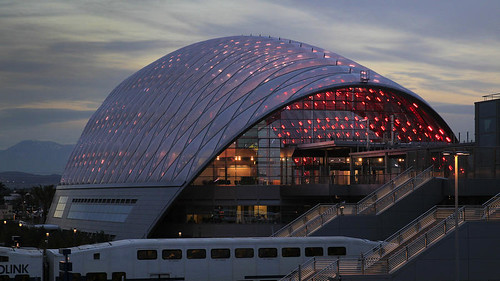
Anaheim Regional Transportation Intermodal Center station. LA Times photo.
11. doing amazing things with Union Station (also see next item), that are more amazing than the current plans including the integration of a major visitor center and transportation museum
12. Create a National Mall streetcar-based transit system integrated with visitor (tourism) services. Many European cities have transit lines that double as tourist conveyances. In SF, the Market Street Railway is a great example of what I am thinking about.

Map of the National Mall and Smithsonian Museums, National Park Service.
13. recognizing that transit stations (subway, railroad, and major bus transfer points) are major entrypoints-gateways into neighborhoods and upgrading them appropriately including artistic elements to Metro station bridges and canopies

Tunnel of Lights, Railroad Park, Birmingham, Alabama, "Light Rails" by Bill FitzGibbons. Photograph by Jenna Nicole Photography.
14. Making arterials integral civic architecture including multi-modality (my "Signature Streets" concept)
15. having more "commuter stores" and making them centers for the promotion and adoption of sustainable mobility modes
16. creating dedicated surface transitways (busways) Downtown and on key arterials
17. relatedly, adding a busway from National Airport to the proposed Long Bridge reconstruction to provide 24 hour transit service to the Airport and to provide redundancy for 14th Street Bridge
18. HOV2 requirements during rush hour on some major arterials

HOV-2 sign, Alexandria, Virginia.
19. an annual regional transit advocates-vision conference
20. undergrounding the through traffic elements of certain commuter-centric arterials in the city to speed their movement and take the traffic off the streets, which has debilitating impacts on abutting neighborhoods
21. and this point, resurrected from Mark Jenkins' original article proposing the Purple Line in the 12/4/1987 issue of the City Paper, of having Purple Line-Metrorail-passenger rail intersection stations (like New Carrollton or Silver Spring), potentially in Rockville, Alexandria, etc., become much better "train stations." Rather than the Silver Spring Transit Center being an example of what is possible, look at the new Anaheim Regional Intermodal Transportation Center.
But speaking of the Purple Line. Build it. And create the bi-county authority and transportation renewal district to offload state financing, to get the current Administration to approve it.
-- "To build the Purple Line, perhaps Montgomery and Prince George's Counties will have to create a "Transportation Renewal District" and Development Authority"
And start planning right now for the segment from Alexandria to New Carrollton, with service including National Harbor. Ideally the same could happen from Bethesda west to Tysons.
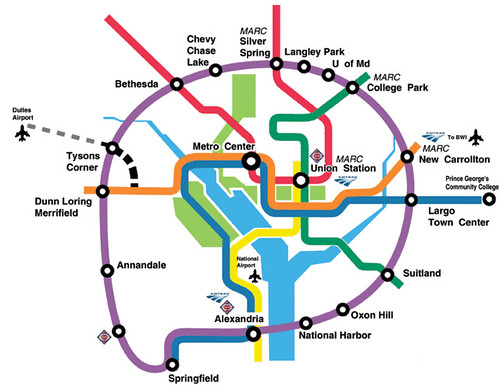
Labels: car culture and automobility, transportation planning, urban design/placemaking




13 Comments:
Dedicated lanes for buses would seem like a big idea worthy of rallying for... if it ever got off the ground.
And I mean not just 16th Street, but a network.
not including a dedicated system of surface transitways especially Downtown is probably the biggest element that is missed in my presentation on Metropolitan Mass Transit Planning.
http://urbanplacesandspaces.blogspot.com/2010/07/metropolitan-mass-transit-planning.html
http://urbanplacesandspaces.blogspot.com/2012/07/metropolitan-mass-transit-planning-more.html
Ok, first, off topic, but this:
http://observationalepidemiology.blogspot.com/2015/05/inequality-and-urbanism.html
You made a comment a long time that GGW needed a "grad-school" component to urbanism, which is how I few your writing. Not fun, pretty painful, but comphrensive.
And DA's article is pretty sad, because while GGW does a great job on the college rah-rah stuff, it all goes back to the decison by WMATA to disband further expansion and let the states do the job. And this is DA realizing that.
So, the rah-rah is dead, a bunch of emails can't save the streetcars, and we are in the slow, unfun grind of incremential expansion
If I may, I think the basic compact is broken between taxpayers and public transit. As our NYC friend larry says, it is being run for the benefit of employees, not the taxpaying public.
So you've got to fix that, and build and fix public transit for the people -- not the states -- that pay for it.
Until then, you are not going to get broad based support.
(and yes, the federal subsidy gets arond that to a degree, but it is also why I suspect non-federal use of Metrorail is plummeting. If you actually have to pay for it....)
So, I'd add:
1. Break the arbitration deal -- wmata is in a death spiral and without changes to the pension benefit formula it is dead.
2. Get out of the para-transit business. Leave it to the states.
3. Build bus lines to move middle class people with jobs. Yes, that means better buses with working ac. Also means making sure the homeless don't camp out on the bus all day.
4. Unify transit payments.
5. It is time to change the board governance. And structure. I'd split bus/rail. Privatize bus if you want. Then create a larger multistate, as you like in Hamburg.
http://en.wikipedia.org/wiki/Hamburger_Verkehrsverbund
It is a basic core competency argument. WMATA does a ass job running a rail system.
there's a lot to respond to. First, I don't know enough about the ins and outs, but yes, WMATA isn't working.
You talk about "core competencies" but the division that's working best is bus. (I am doing massive cleaning of the basement because I hadn't reconstructed it since the installation of the French drains and we have people coming to stay... and one of the things I came across is the binder from the 2006 regional bus conference.)
I keep writing about the need to rebuild the consensus about transit and the public. I've been writing that since 2009.
And about doing real regional transportation planning, and that beyond WMATA.
(In the thread on GGW someone asked why didn't anyone mention Georgetown's gondola idea. WMATA was broached on the subject and said they had no interest. If it's not subway or bus, it doesn't matter to them.)
You're right about the transit agency as an employment function. The arbitration and the pension issue makes things unsustainable for the agency long term, especially because of the politics of Virginia, and ultimately, the financial constraints of Maryland.
And once the cost of transit gets so high where people have to pay in despite the transit benefit (it's only covers "full cost" if you live in Arlington, DC or Bethesda/Silver Spring), it gets to the point where when people are faced with the drive/transit make or break decision, they may not choose transit.
getting back to Hamburg, despite the fact that there are something between 30 and 40 providers, ultimately Hamburg Hochbahn (subway and bus in the city) and Deutsche Bahn's S-Bahn commuter rail runs the bulk of the service. And they do a great job.
It's why I suggest WMATA hire people from Germany to run the system, but it might not be feasible. Because culture and expectations and accountability are the big problem.
e.g. didja see the article about "the change to the Operations Manual" with new directives about "not talking when there are emergencies if you are not part of the response team." WTF.
Ideally, if DC were run great, had great vision, etc., it could have run the WMATA agency with contracting from the suburbs, because transit is essential to the city.
But as we know, ultimately that doesn't work, because eventually the financial needs of the transit system grow beyond the center city's capacity to fund.
The only exception that readily comes to mind is the SF MUNI system, which has never gone outside the bounds of the city, and is complemented by BART and other services.
But once it becomes a "state-type authority" agencies tend to get f*ed up, because so much other stuff becomes part of the decision making process.
wrt the grad school vs. sophomore level discussion, as you can imagine, that's bugged me for a long time, especially because of the way that GGW is portrayed. E.g., "the award" David gets from CSG. While deserved, GGW is too busy patting itself on the back to build up the quality of its output and ultimately, the ability to shape the vision and outcomes going forward.
(CSG has this problem too. Especially because they support virtually anything developers propose, even if the initial proposals aren't a good fit and/or congruent with a particular location and urban design.)
OTOH, being the knowledgeable somewhat respected outsider isn't working so great for me personally, and it wastes a lot of potential forward progress.
this problem is accentuated by the velocity of staff turnover in agencies. These days, lots of people no longer know who I am, and the people at the top aren't interested in mining it. (E.g., I complained to some high level transpo planners in DCG about the "innomaytion" thing on "transit" innovation, and not being invited, and it turns out they weren't even engaged in it either, hadn't been notified or invited.)
the krugman piece is important. FWIW, I haven't figured out how to "revitalize people" as opposed to places.
As PK points out without using the term "agglomeration economies," cities are all about maximizing connections between smart, able, focused and _socialized_ people.
The book _Future once happened here_ is widely derided by progressives, but it discusses how cities were overwhelmed by inmigration of violent rural people. In cities with a great degree of African-American inmigration, this came with a large dose of attitude that socialization "was white" and oppressive, rather than an inculcation of the basic behaviors and attitudes necessary to interact, engage, and work with other people.
It's easy to overgeneralize, but got on the Metro and picked up a plastic bottle that had been bouncing around. A little kid admonished me, telling me to throw it out of the car. I told him that responsible people picked up trash and recyclables and properly disposed of them, that it's about responsibility and taking care of a common environment.
His mother later explained to him that it was fine to leave stuff on the floor or in public space, that it wasn't their responsibility.
I've had other similar experiences for years, that was just the second most recent, within the last 5 weeks.
fwiw, of major cities, DC always seems the absolute dirtiest to me, excepting NYC because of the volume and I suppose parts of Los Angeles--but it is cleaned up in a lot of places overnight, only to start again the next day.
That is the result of people (1) not taking responsibility or (2) not believing that they are part of the community and therefore evincing no interest in helping to maintain the community.
In any case, you can't have a functioning metropolis if people aren't connected and take some responsibility...
My big ideas about developing a robust public realm, network of civic assets and programs are theoretical. It could be that they won't make much difference.
Relatedly, there is finally a "marketing committee" for Eastern Market, ad hoc, but it's a really good group of people, a lot of good insights, etc. (But the committee hasn't started because I've argued for the need for 8 years, it's because all the rampant competition for food and craft sales has cut into EM's once market leading pre-eminence and people are making less money. So now they see the need.)
... anyway, a couple meetings ago the chair had us do an exercise about "the negatives" of the market (we had been focusing on the benefits and pluses).
He is part of the old guard, big into local politics, etc., but he was very insightful (if not biting, about EM being too much in the past).
He is a realtor and he made the point that the people buying houses and living in Capitol Hill today are much different than the people who bought in 20 and 30 years ago. He called the now older buyers more "Peace Corps" types.
In thinking about it later, I realized this is exactly why I don't like services like Uber, etc.
The people buying in the city now are buying mostly because trends favor urban living and they have the money. They weren't so to speak "mission driven" committed to urban living, bringing back the city, waging war against mayhem, living in a diverse, heterogeneous community (not sure if that was ever really true, the segregation of white vs. black areas was quite pronounced even then).
Those people, and I include myself among them, are different from the people who buy today, who have a lot of money, who buy their amenities, and are fully happy living in an e-connected but community- and people- disconnected world.
the difference, using the Rogers diffusion curve, is between innovators and early adopters (who make up about than 15% of the population), and early (34%) and late majority (34%), followed by "the laggards" (16%).
http://www.flickr.com/photos/rllayman/15121966370
We're probably in the late stages of the early majority, and plenty of people (a la Leinberger) will never be interested in living in the city...
But the people who move in now, as the city has been "pacified" are much different.
E.g., I was in the H St. neighborhood last night, and I was thinking back to 1987... It's completely unbelievable now, the demographic mix of people walking from the Metro on M St. NE. Totally unfathomable that this was 3 blocks from one of the city's biggest crack distribution areas.
Or this one dude in the early 2000s (now he's a journalist) who allegedly was gonna join my Main St. committee. He argued with me about saving the Uline, because "there are rats in it".
Now it's being renovated to become one of the national flagship stores for REI.
We "set the stage" for the city to be appropriated by others.
well perhaps that is the "World class consultant"
Good point on bus. With smartphones (nextbus), payment card, and mapping bus really is well placed. What you need is some basics (as I said, AC really helps), cleaning, and better route placement.
Re: GGW, it is always better to have someone create a bigger pool and get more people interested. I don't have a problem with that. I do get upset when it turns from college into high school and culture war (cars are evil).
RE: krugman, I brought up a related point a a while ago, which is the old concentric models of the city were also premised on continued immigration. When that stopped in the 1920s, the people in the middle got caught there since nobody new came in to buy them out.
Not sure if I buy the country person line, which has been used since about 1910. You see it in the 3rd world -- people who use the street as bathrooms since they don't know what a bathroom is. The pathologies we have in DC seen far more recent.
not country persons, just a propensity for violence (which extended to whites too, e.g., the Hatfield-McCoy feud).
And I've had plenty of conversations with older Af-Ams about their perception of the oppressiveness of white-controlled municipal institutions.
But it wasn't limited to whitey.
dk if you caught the paragraph in a column by Colbert King awhile back, recounting a conversation with Edward Brooke, about how Black nationalists justified the demolition of old Dunbar because of its associations with the Black elite.
what Siegel called those pathologies included "dependent individualism" which I define as "I can do whatever I want and you have to pay for it."
Now he uses the term "entitlement economy."
http://urbanplacesandspaces.blogspot.com/2009/10/how-big-cities-go-badthe-entitlement.html
You have to be clear about what you mean when you say that "WMATA disbanded their construction operation."
Who is WMATA? WMATA is an organization; WMATA is also a regional body goverened by a board.
What you really mean here is that the WMATA Board of Directors didn't want to sign on to the plans that WMATA staff had put together for future expansion, so WMATA the organization had no choice but to lay off those staffers.
You want to pawn paratransit off to the states? The states already are responsible for paratransit; they've assigned that work to WMATA. Someone ends up paying for it no matter what.
Thank you for providing such a valuable information and thanks for sharing this matter.
Post a Comment
<< Home